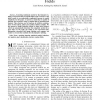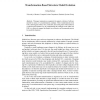1826 search results - page 33 / 366 » Using Random Forests in the Structured Language Model |
IJCNLP
2005
Springer
14 years 2 months ago
2005
Springer
Abstract. Linguistic information can help improve evaluation of similarity between documents; however, the kind of linguistic information to be used depends on the task. In this pa...
PAMI
2008
13 years 8 months ago
2008
Abstract-- Extending traditional models for discriminative labeling of structured data to include higher-order structure in the labels results in an undesirable exponential increas...
UML
2005
Springer
14 years 2 months ago
2005
Springer
This paper summarizes an approach to support evolution of software models by means of a transformation catalogue. These transformations treat UML class diagram models, OCL constrai...
AGENTS
2001
Springer
14 years 1 months ago
2001
Springer
The specific organization used by a multi-agent system is crucial for its effectiveness and efficiency. In dynamic environments, or when the objectives of the system shift, the ...
IJCNN
2006
IEEE
14 years 2 months ago
2006
IEEE
—We present a structured model of context that supports an integrated approach to language acquisition and use. The model extends an existing formal notation, Embodied Constructi...


